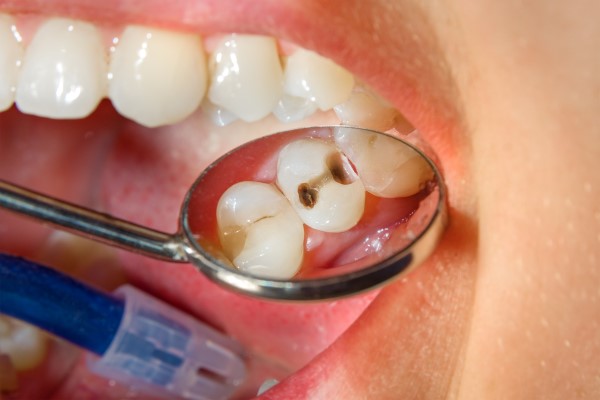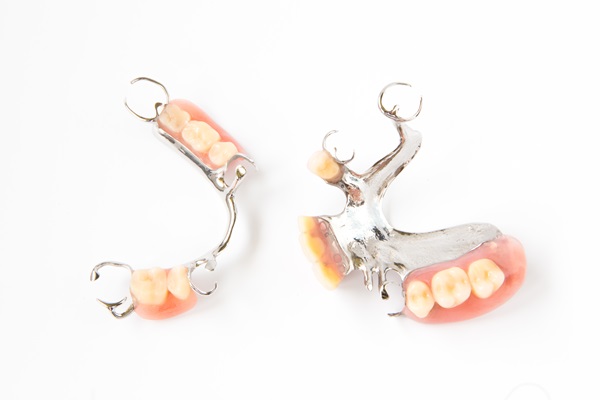How Can I Tell If I Have a Cavity?

A cavity is one of the most common dental issues that people develop, and it can leave a tooth vulnerable to serious oral issues like infection. Cavities are extremely small when they first start forming, which can make it a challenge to spot them. The Centers for Disease Control and Prevention states that about 30% of people in the U.S. are living with untreated cavities.
Cavities are caused by oral bacteria creating acids that eat away at teeth. The cavity will continuously expand when left untreated until the tooth is destroyed.
Signs that you might have a cavity
Let us take a look at signs that let you know that a cavity might be forming on one of your teeth.
1. Increased sensitivity to hot and cold foods/beverages
Increased teeth sensitivity that lingers after consuming cold or hot foods and beverages is often a sign that dentin has been exposed due to decay. The dentin is an inner layer of a tooth that contains many tiny nerve endings. Dentin being exposed to irritants like acidic, sweet, cold, or hot items often leads to irritation and pain.
2. Toothache
A reoccurring toothache might be a sign of a cavity forming in a tooth. It is one of the first signs of tooth decay, and the pain is often spontaneous. At times, the pain can be triggered by the things that a person eats or pressure from chewing.
3. Stains forming on a tooth
White spots forming on a tooth can be an early sign of tooth decay. Over time, tooth decay will lead to darker discoloration as the tooth rots away. Stains caused by tooth decay tend to appear on a tooth’s outer surface.
4. Holes on your teeth
As tooth decay worsens, a person might be able to feel holes forming on their teeth with their tongue or fingers. Food particles often find themselves getting stuck in these holes, which creates an ideal environment for oral bacteria to continue creating acids that eat away at teeth.
Dentists typically fix these cavities by filling them up with dental filling. Composite fillings are one of the most popular types of filling because they can be color-matched with the rest of the patient’s teeth.
5. Bad breath
Cavities tend to lead to bad breath due to food getting stuck in them. At times, food particles can be lodged in these holes for weeks, creating volatile sulfur gases that do not smell pleasant. Closing the cavity with filling helps bring this to an end.
6. Pain when chewing
Having a cavity sometimes leads to pain when the tooth is touched or experiences bite forces. It can force a person to have to eat with only one side of their mouth to prevent aggravating the damaged tooth.
Stop cavities early
The earlier cavities are detected, the easier they are to treat, leading to lower dental bills. Call or visit our San Dimas clinic to set up an appointment with our dentist.
Request an appointment here: https://sandimassedation.com or call San Dimas Family and Sedation Dentistry at (909) 305-2300 for an appointment in our San Dimas office.
Check out what others are saying about our dental services on Yelp: Cavity in San Dimas, CA.
Recent Posts
Good oral hygiene is more important than ever now because you may not be going to your regular appointments. Under normal circumstances, it is recommended to visit your dentist every six months for cleanings and exams. However, because you may be missing appointments, you should take better care of your teeth than before. Read on…
The coronavirus pandemic has led to dentists changing the way their clinics operate to improve infection control. Many of these changes are based on guidelines provided by the American Dental Association. The goal of making these changes is to limit the risk of both dentists and their patients getting infected with COVID-19 while at the…
The sterilization and disinfection of all equipment and instruments are a part of the infection control protocol all dentists follow. While this has always been important, the COVID-19 pandemic has put it at the front of your mind. Now, you want to know what your dentist does to prevent the transmission of diseases. Your dentist…
A dentist can discuss the normal tooth’s basic parts during a dental checkup. The crown is the visible part above the gumline. The root is the inferior part below the gumline. Well-trained dentists can provide patients with dental crowns that have the natural color of their teeth during a dental checkup. Here are some important…


